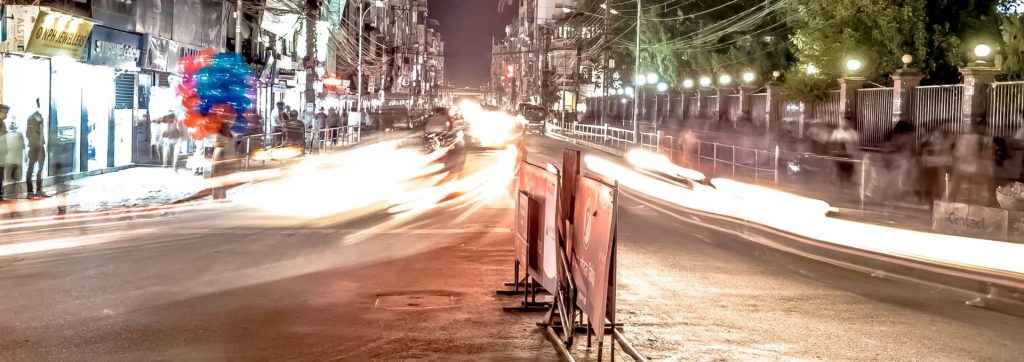Walkability in Urban Spaces in Nepal

Sustainable mobility includes walking, biking and public transit. Walking is the natural mode of transportation, creating the largest transportation mode shared in Nepal’s urban cities. However, the current urbanisation and motorisation do not provide a safe and pleasant walking environment. Walkability is the quality of the place with diverse functa Sustainable mobility includes walking, biking and using public transit. Walking is the natural mode of transportation. However, the current urbanisation and motorisation do not provide a safe and pleasant walking environment in Nepal’s cities. Walkability is the quality of the place with diverse functions within walking distance, well connected and accessible spaces for every person, green natural environment and safe streets to walk. Walkable cities are characterised by a high concentration of mixed-use buildings, street connectivity with short block lengths and few cul-de-sacs, important landmarks that create good legibility and good public amenities accessible to all users.
To develop sustainable mobility guidelines, it is essential to understand the street types and urban quality parameters for creating safe, comfortable and accessible streets. According to the urban design principles, the following points can be taken as guidelines for the walkable city.
Diversity
Diverse land use from residential, commercial, health, education and employment. Mixed-use buildings provide different activities within a local environment that reduces the necessity of long-distance mobility.
Connectivity
Good street connectivity created by short block length, many visible short links, many intersections and fewer dead ends.
Legibility
Landmarks and nodes are essential to avoid disorientation and getting lost in the city.
Sidewalks and urban furniture
Sidewalks comprise three zones; free zone, service zone and transition zone. The free zone is where people walk, and the service zone is where street furniture like benches, street lamps and trash bins are located, and the transition zone is the space between the free zone and building entrance.
Universal accessibility
The streets should be accessible to a wide spectrum of users, including people in the wheelchairs, pregnant women, elderly and children. Special street design considerations such as tactile on the surface, ramps, audiovisual sound, visual contrast and gentle gradients should be made to increase the street’s inclusivity.
Greenery and unpolluted space
The trees and landscape strips are the best buffer elements between the sidewalk and vehicular street. They provide shade and a natural environment to the road and reduce pollution.
Safety
Good surveillance on the street is essential to avoid insecurities. The street with active ground floors, many shops, many openings and transparency have eyes on the street that help to minimize the crimes. The street between the blind walls, dark streets and underpasses are a risk to walk.

In the context of urban cities in Nepal, we do not find a safe walking environment and pedestrian-friendly streets due to lack of sufficient sidewalks, zebra- crossings, traffic congestion, poor public transportations, street vendors, urban pluvial flooding in the rainy season and pollution. These are the general challenges of mobility in the urban cities for decades due to increasing urbanization and motorisation process.
The roads are widened but no proper sidewalks are made. Instead, the walking spaces have encroached for the vehicles which are a big threat for pedestrians. As urban designer Jan Gehl says, “More road more traffic, less road less traffic,” bigger roads are not the solution for traffic congestion. So, instead of widening the roads for vehicles, Complete Street’s concept that includes all road users and activities should be made with the key initiatives like pedestrian pathways, protected bike lanes, street lights and green landscapes.
To avoid traffic congestion, the streets can be pedestrianized depending upon the characteristics of those streets. Pedestrian Streets are car-free streets with controlled access for service vehicles like emergency services and delivery vans. Depending upon the restriction types, Pedestrian Streets can be full-time or part-time pedestrian streets. Pedestrian Streets’ examples can be seen in other countries, mostly in the city centres and old towns where there is a high pedestrian flow volume. The municipalities of Kathmandu had also been trying to implement the car-free zone in the historical squares in the city centre, which was not successful initially but had a good result in the Thamel area. Where the concept of Pedestrian Street is difficult to apply, the special design considerations like first priority to pedestrians and regulation for the vehicles should be maintained to create Shared Street which integrates all road users with a low volume of vehicles.

The connectivity of the streets should be improved by creating short links if the urban blocks are bigger than 10,000 square metres. Proper and visible signage should be created to help pedestrian orient where there are more than four junctions.
To reduce the number of car users and pollution, other sustainable mobility like bicycles, rickshaws and eco-friendly vehicles, bike shares and e-bikes should be promoted. Similarly, the quality of public transportations should be improved and the number of bus routes should be increased to make it accessible to all people. The condition of bus stations should be improved and maintained. Encouraging bicycles and improvement in public transportations can also help reduce parking problems in the city.
Regarding vendors encroachment in some streets, the government should make actions and policies without affecting the livelihoods of the street vendors and the culture of street vending. Similarly, the other urban problems like waste and drainage should also have proper management programmes in every municipality.
To conclude, mixed-use functions, good connectivity and legibility of spaces, accessible sidewalks and amenities, green landscapes and safety are the urban qualities that make a walkable city. The municipalities and the responsible departments should develop more initiatives for safe, connected, accessible and pleasant walking environment.







